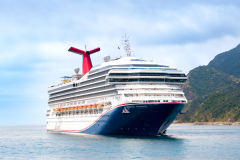
Carnival announced record earnings, but loyalty program changes in its flagship Carnival brand may cause future problems.
GC Images
Carnival Corporation just reported record quarterly earnings, beating analyst expectations with $2.8 billion in revenue and its highest-ever booking levels. The stock immediately dropped 7%. Wall Street analysts cited concerns about fuel costs and Mediterranean demand, but there’s a deeper problem hidden beneath those stellar numbers. the insensitive loyalty program overhaul at its flagship Carnival brand showed the company doesn’t understand what drives true customer loyalty, and why breaking trust with your most loyal customers can’t be fixed with priority tender boarding.
The Betrayal That Sparked a Revolt
Back in June, Carnival announced it was scrapping its decades-old lifetime loyalty program in favor of a spend-based system requiring customers to shell out roughly $33,000 every two years to maintain elite status. The reaction was swift and brutal.
“37 years, 31 cruises gone down the drain. Felt that slap on the face,” one longtime cruiser wrote on YouTube.
The fury wasn’t just about losing perks. It was about betrayal. These customers had spent decades building what they thought was lifetime status—something they had earned and owned. Behavioral economists call this the “endowment effect”—we value things more once we possess them. Taking away something people believe they own feels far worse than never giving it to them in the first place.
One poignant email I received noted, “My wife and I are 30-year cruisers with Carnival, 62 cruises, 345 cruise nights, and achieved lifetime Diamond status 11 years ago. We have never sailed on another cruise line… Now, Carnival is reneging on their ‘lifetime’ promise… Carnival has revealed their true ($$) colors and there is nothing the brand can do to regain our loyalty.”
Carnival’s Partial Retreat: Diamonds Win, Others Lose
Encountering this unexpected backlash, in mid-September Carnival announced “enhancements” to placate angry loyalists. Diamond members, the highest tier, will keep their lifetime status. Platinum and Gold members? They’re still losing theirs after a grace period. Platinum members get extended until 2028 and both tiers will receive priority tender boat boarding and unspecified “additional exclusive benefits” to be announced later.
This selective protection lets Diamond members breathe a sigh of relief, but Platinum members who spent years building toward Diamond status now face a different kind of betrayal. They’re not quite loyal enough to save.
Research on goal pursuit shows that “almost making it” creates stronger negative emotions than never being close at all. A Platinum member with 180 days at sea (Diamond requires 200) doesn’t see Carnival’s partial retreat as generous—they see it as proof that their years, or even decades, of loyalty meant nothing. The message seems to be, “You’re loyal, just not loyal enough to matter.”
Why Token Gestures Fail
Carnival’s “enhancements” reveal a fundamental misunderstanding of customer psychology. Priority tender boarding—getting on those small boats that ferry passengers to shore a few minutes earlier—is a minimal benefit. Indeed, too many priority guests was one reason for the progam changes. What customers lost was emotional: recognition, achievement, and identity as valued members of the Carnival family.
The vagueness of promising “additional exclusive benefits” without specifics suggests even Carnival knows their current offerings aren’t enough.
This mirrors what airlines discovered when they shifted from miles-flown to dollars-spent loyalty programs. Frequent business trave




